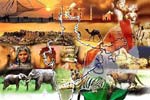
India is a country in South Asia. It is the Seventh-Largest country by area and second-largest by population and most populous democracy in the world. Home to Indus Valley Civilization and a region of historic trade route and vast empires, India is a country where sights, sounds, hustle and bustle of the city contrasts with the open plains of Rajasthan desert, the calm waters of the Kerala backwaters and the dizzying heights of the Himalayas. This constitutional republic’s puzzle board of 27 states holds virtually every kind of landscape imaginable. Four major world religions: Hinduism, Jainism, Buddhism and Sikhism originated here
Set apart from the rest of Asia by the supreme continental wall of the Himalayas, the Indian subcontinent touches three large bodies of water and is immediately recognizable on any world map. There are deep cultural continuities that tie its people together. North India is the country's largest region. It begins with the panhandle of Jammu and Kashmir, a dynamic area with terrain varying from arid mountains in the far north to the lake country and forests near Srinagar and Jammu; then widening into the fertile plains of Punjab to the West. West India contains the states of Gujarat, Maharashtra, Goa, and part of the massive, central state of Madhya Pradesh. Home of the sacred Ganges River and the majority of Himalayan foothills, East India begin with the states of Madhya Pradesh, Bihar, Odisha, which comprise the westernmost part of the region. East India also contains an area known as the eastern triangle, which is entirely distinct. India reaches its peninsular tip with South India, which begins with the Deccan in the north and ends with Cape Comorin.

Mark Twain once said: "So far as I am able to judge, nothing has been left undone, either by man or nature, to make India the most extraordinary country that the sun visits on his rounds. Nothing seems to have been forgotten, nothing overlooked."

